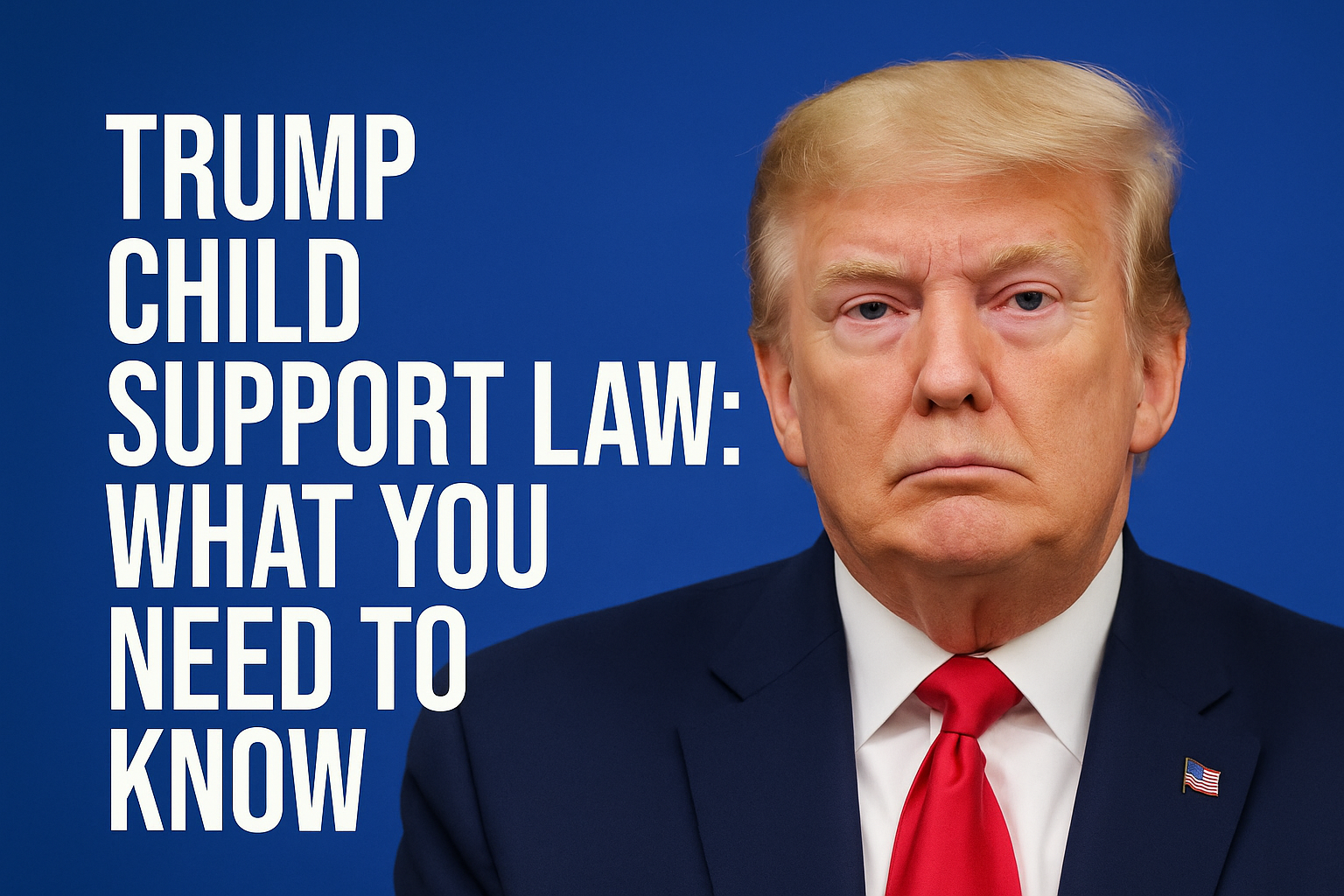Trump child support laws have been of great concern and have left parents, legislators as well as attorneys in confusion. It cannot be suggested that Trump enacted just one comprehensive child support legislation but different moves related to the United States policy related to child assistance confirmation practices were introduced during his government, with a shift in tax legislation. Such developments have brought different views on impacts that they exert on poor-income parents, fatherly rights, and the state and federal agencies relationship in respect to child support enforcement.
We are going to talk about the real meaning of the child support trump, the manifestations they caused and what it can mean to the future. The different responses, legal criticisms and the chances one may witness the occurrence of any of the so many proposed child support laws in 2025, being actively campaigned under the name of trump, will also be a part of it.
What Is the Trump Child Support Law?
In common language, the term new child support laws 2025 trump denotes the policies and administration actions under or being affected by the presidency of Donald Trump, largely concerning the policy of child support, at the federal level and there was no single piece of legislation with this term; nevertheless, various changes within the Trump administration were accomplished on an executive order, budget requests or federal government departmental policy.
The changes have all dealt primarily with the enforcement betterment, fraud reduction, and promotion of parental responsibility among noncustodial fathers. The Trump administration went to work with HHS and OCSE to modernize a decades, old system many viewed as inefficient or punitive, especially for low-income earners.
Overview of Federal Child Support

Prior to examining Trump’s impact on the enforcement of child support, it is imperative first to understand how the federal child support system works. In the United States, child support enforcement occurs in partnership with an agency action at the federal level and an agency action at the state level, the federal government setting broad guidelines while the states execute those rules through family courts and child support agencies.
Under the Title IV-D of the Social Security Act, the Child Support Enforcement Program is in charge of the paternity establishment, locating the absent parent, enforcement of support orders, and collection of payments. States have leeway; however, the federal government can proactively require compliance through its funding and auditing activities, therefore making any reform at the federal level, such as Trump child support tax law, very significant.
Trump Views on Child Support
In fact, during the presidency, he endorsed measures to ensure firmer enforcement, except family values and accountability from noncustodial parents. He was indeed concerned about “deadbeat dads.” He said that money should be sent by the fathers into the household. He has always talked of child support in a broad sense and as such fairness from both parents.
Critics claim that for Trump on child support and taxes are more about enforcement than reform, although his administration sponsored fatherhood responsibility programs. Even then, his temperament caught the support of collection tactics whose methods sometimes penalized a poor or unemployed parent laboring to meet support obligations.
His child-support messaging tended to follow the same pattern as his politics in general, aggressive, achievement-driven, even sometimes controversial. Although he addressed the promotion of strong families and that fathers take greater responsibility for them, critics claimed that his rhetoric of accountability did not reveal much in terms of compassion and the complexity of such a message when it was directed to economically deprived people.
Policy Changes During Trump Era
Various policy proposals and administrative changes in child support enforcement were introduced during the time of Trump. Not all were able to find legislative approval; still, they served to signal the administration’s priorities with regard to family support obligations. The Key Policy Changes:
- Encouraging work programs for noncustodial parents receiving governmental aid.
- Increased cooperation of federal tax agencies with child support enforcement for intercepting tax refunds from delinquent payers.
- Pilot programs on mediation and co-parenting meant to reduce family conflict and improve compliance.
Though none of these reforms were described in terms of the “Trump child support 2025” vision, they constituted an essential base for future discussions on the reform of the system.
Enforcement Reforms During Trump Era
One of the most evident aspects of child support law Trump administration has espoused has been increased enforcement. The OCSE under Trump drove enhanced tactics to locate abdicating parents, enforce payment orders, and intercept federal payments bad-checking like stimulus checks, tax refunds, etc.
The following is a list of enforcement mechanisms expanded under Trump:
- Wage garnishments and direct paycheck deductions
- Suspension of driver’s licenses and professional licenses
- Seizures of federal tax refunds (Related to Trump child support income tax enforcement)
- Passports denied or revoked for parents in substantial arrears
- Bureau of Credit Reporting coordination
These truly sought to give children their due share of support, critics charged, but more often than not, they pushed low-income and struggling parents deeper into hardship.
Impact on Low-Income Parents
The changes made to child support enforcement during that era brought serious concerns over the effects on low-income parents, mostly those who were unemployed or underemployed. Many of these parents were already in jail, had their wages garnished, or suffered credit damage because of nonpaying child support, mostly because they did not have the means to work it out.
Backers of Trump’s policies argued that stronger enforcement would teach responsibility and reduce dependency on welfare. Detractors said that without real reform to help the parents affected, enforcing measures would punish the poor, locking them instead into cycles of debt and incarceration.
Tax Law and Child Support
The area where child support and tax law had an impact during Trump’s presidency was a hugely contested topic. The very far-reaching changes made to the U.S. tax code under the aegis of the 2017 Tax Cuts and Jobs Act (TCJA) had far-reaching effects on child support payments and obligations. Under the TCJA:
- Alimony payments are no longer deductible by the payer nor considered income for the purpose of receiving by the recipient.
- Dependency exemptions were eliminated, lessening tax relief prospects for noncustodial parents.
- Tax refund intercepts for unpaid child support increased, giving rise to complaints on the “Trump child support tax law” variants.
That meant that noncustodial parents with a pre-TCJA alimony payment deduction could be liable for more taxes and have fewer ways to manage their child support obligations.
Fatherhood and Responsibility Programs
In parallel with the regime’s enforcement-first approach, some fatherhood and family responsibility programs meant to facilitate long-term child support compliance were provided with support during the Trump administration. The aim of these programs was to provide incentives for non-custodial fathers to take an active role in the lives of their children, both financially and emotionally. Above Representation in These Programs:
- Vocational training and placement services.
- Education for parents and conflict resolution.
- Mediation services to alleviate court battles.
- Support networks to formerly incarcerated parents.
Such programs would be heavily overshadowed by newspaper headlines about taxes and enforcement, yet their rhetoric seemed to echo a more rehabilitative strain aligned with broader attempts to end cycles of child support debt.
Legal Criticism and Opposition
Proposals on child support law Trump initiatives have met opposition from legal advocacy groups, professional family law practitioners, and civil rights organizations. According to critics, most enforcement measures have violated due process rights, whereby individuals are penalized with no formal opportunity to determine their ability to pay.
Another view against this is that the collection of tax refunds and revocation of licenses is done without much representation, which leaves several communities worse affected. The lack of judicial reforms and heavy reliance on aggressive collections have led to charges that the Trump approach is more punitive than constructive.
Response at the State Level
Child support enforcement goes hand-in-hand with state laws; hence, Trump’s policies earned different reactions in different parts of the U.S. Several states embraced Trump’s advocacy for tighter enforcement and federal cooperation, adding some of his measures like automated wage garnishment and cross-agency data sharing into the local codes.
Some other states saw such changes as bringing antagonism into the rule of law by stressing rehabilitative instead of punitive perspective. Thus, instead of states having programs that focus toward employment support, mediation, reduced penalties for the low-income parent category, were more relevant in progressive states. This bridging of the states highlighted federal freestanding flexibilities and frictions.
Long-Term Policy Effect
Most of the Trump child support law changes were administrative rather than legislative but would change how enforcement agencies and courts would interpret nonpayment and compliance. Such reforms have set the stage for continuing debates way past 2025.
The Trump supporters speak about new child support laws 2025 Trump, and as discussions evolve, there may be a stronger push to juxtapose child support issues with economic realities. The Trump years reflected the power family law bore in its favor and against it; these laws left a shadow of tension between strict enforcement techniques and support-based interventions.
Conclusion
The conversations surrounding Trump child support 2025 are rooted in changes made during his presidency, which carried the message of enforcement, responsibility, and reform of outdated systems. Although these proposals were not framed within a single bill, they impacted real changes, including aspects of tax policy, low-income parents, and federal enforcement patterns.
In all likelihood, as these different facets of the child support system continue to take shape, the approximation of child support law under Trump would enter the national discourse on family welfare and financial justice.





